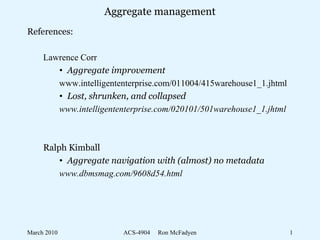
Aggregation
- 1. March 2010 ACS-4904 Ron McFadyen 1 Aggregate management References: Lawrence Corr • Aggregate improvement www.intelligententerprise.com/011004/415warehouse1_1.jhtml • Lost, shrunken, and collapsed www.intelligententerprise.com/020101/501warehouse1_1.jhtml Ralph Kimball • Aggregate navigation with (almost) no metadata www.dbmsmag.com/9608d54.html
- 2. March 2010 ACS-4904 Ron McFadyen 2 Aggregate Navigation From “20 criteria for dimensional friendly systems” #4. Open Aggregate Navigation. The system uses physically stored aggregates as a way to enhance performance of common queries. These aggregates, like indexes, are chosen silently by the database if they are physically present. End users and application developers do not need to know what aggregates are available at any point in time, and applications are not required to explicitly code the name of an aggregate. All query processes accessing the data, even those from different application vendors, realize the full benefit of aggregate navigation.
- 3. March 2010 ACS-4904 Ron McFadyen 3 Aggregation • Created for performance reasons • Using one base star schema, many aggregates can be defined • Some dimensions could be lost, some shrunken or collapsed – see Corr’s articles Customer Date Product Store Transaction Price Cost Tax Qty Consider the Transaction-level schema:
- 4. March 2010 ACS-4904 Ron McFadyen 4 Aggregation Customer Date Product Store Transaction Price Cost Tax Qty Month Product Store Price Cost Tax Qty Transaction-level schema Aggregate schema with: •lost dimensions (transaction, customer) •shrunken dimension (month) •metrics are accumulated over the transactions, customers, month
- 5. March 2010 ACS-4904 Ron McFadyen 5 Aggregation • Suppose you must create the schema: • What are the steps to do so? – Product and Store already exist, but the others must be created Month Product Store Price Cost Tax Qty
- 6. March 2010 ACS-4904 Ron McFadyen 6 Aggregation Design Goal 1 • Aggregates must be stored in their own fact tables; each distinct aggregation level must occupy its own unique fact table
- 7. March 2010 ACS-4904 Ron McFadyen 7 Aggregation Design Goal 2 • The dimension tables attached to the aggregate fact tables must be shrunken versions of the dimension tables associated with the base fact table Product ProductSK SKU Description Brand Category Department Category SK? Category Department Category is a shrunken version of Product Attributes names from Product What values does the PK of Category assume? What name should the PK of Category have?
- 8. March 2010 ACS-4904 Ron McFadyen 8 Aggregation Design Goal 3 • The base atomic fact table and all of its related aggregate fact tables must be associated together as a “family of schemas” so that the aggregate navigator knows which tables are related to one another. – Kimball’s paper presents an algorithm/technique for mapping an SQL statement from a base schema to an aggregate schema
- 9. March 2010 ACS-4904 Ron McFadyen 9 Aggregation Design Goal 4 • Force all SQL created by any end-user data access tool or application to refer exclusively to the base fact table and its associated full-size dimension tables.
- 10. March 2010 ACS-4904 Ron McFadyen 10 Kimball’s Aggregate Navigation Algorithm 1. For any given SQL statement presented to the DBMS, find the smallest fact table that has not yet been examined in the family of schemas referenced by the query. "Smallest" in this case means the least number of rows. Finding the smallest unexamined schema is a simple lookup in the aggregate navigator metadata table. Choose the smallest schema and proceed to step 2. 2. Compare the table fields in the SQL statement to the table fields in the particular Fact and Dimension tables being examined. This is a series of lookups in the DBMS system catalog. If all of the fields in the SQL statement can be found in the Fact and Dimension tables being examined, alter the original SQL by simply substituting destination table names for original table names. No field names need to change. If any field in the SQL statement cannot be found in the current Fact and Dimension tables, then go back to step 1 and find the next larger Fact table. 3. Run the altered SQL. It is guaranteed to return the correct answer because all of the fields in the SQL statement are present in the chosen schema.
- 11. March 2010 ACS-4904 Ron McFadyen 11 Aggregate Navigation www.intelligententerprise.com/000929/feat1.jhtml “Other data mart capabilities worth mentioning are aggregation and aggregate navigation. The nature of multidimensional analysis dictates the extensive use of aggregation. … Both UDB and O8i provide a database-resident means for navigating user queries to the optimum aggregated tables”
- 12. March 2010 ACS-4904 Ron McFadyen 12 Materialized Views An MV is a view where the result set is pre-computed and stored in the database Periodically an MV must be re-computed to account for updates to its source tables MVs represent a performance enhancement to a DBMS as the result set is immediately available when the view is referenced in a SQL statement MVs are used in some cases to provide summary or aggregates for data warehousing transparently to the end-user Query optimization is a DBMS feature that may re-write an SQL statement supplied by a user.
- 13. March 2010 ACS-4904 Ron McFadyen 13 Materialized Views Oracle example: CREATE MATERIALIZED VIEW hr.mview_employees AS SELECT employees.employee_id, employees.email FROM employees UNION ALL SELECT new_employees.employee_id, new_employees.email FROM new_employees; SQL Server has “indexed views” … see http://www.databasejournal.com/features/mssql/article.php/2119721
